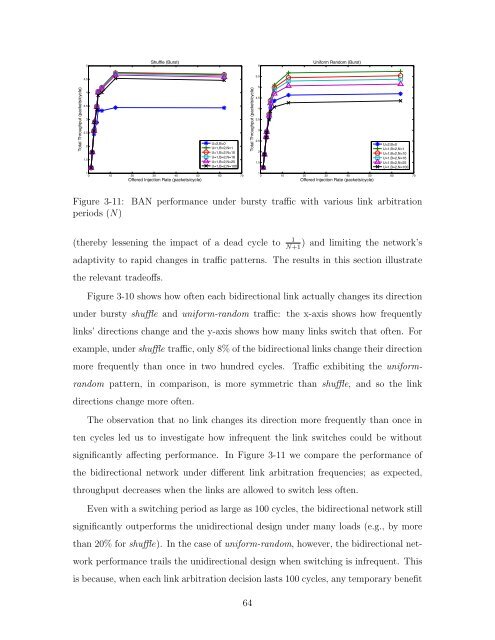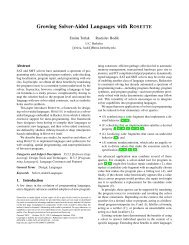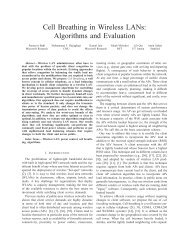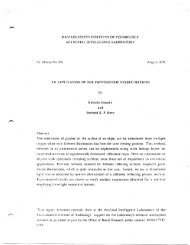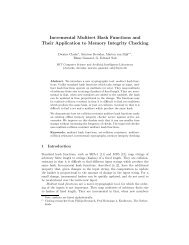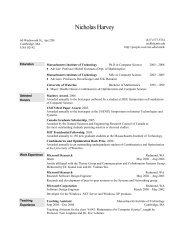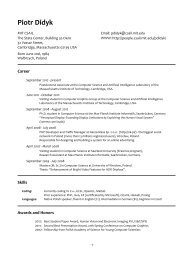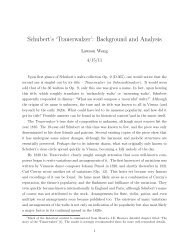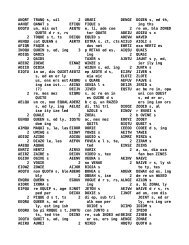On-chip Networks for Manycore Architecture Myong ... - People - MIT
On-chip Networks for Manycore Architecture Myong ... - People - MIT
On-chip Networks for Manycore Architecture Myong ... - People - MIT
You also want an ePaper? Increase the reach of your titles
YUMPU automatically turns print PDFs into web optimized ePapers that Google loves.
5<br />
Shuffle (Burst)<br />
6<br />
Uni<strong>for</strong>m Random (Burst)<br />
4.5<br />
5.5<br />
Total Throughput (packets/cycle)<br />
4<br />
3.5<br />
3<br />
2.5<br />
2<br />
1.5<br />
U=2,B=0<br />
U=1,B=2,N=1<br />
U=1,B=2,N=10<br />
U=1,B=2,N=16<br />
U=1,B=2,N=25<br />
U=1,B=2,N=100<br />
1<br />
0 10 20 30 40 50 60 70<br />
Offered Injection Rate (packets/cycle)<br />
Total Throughput (packets/cycle)<br />
5<br />
4.5<br />
4<br />
3.5<br />
3<br />
2.5<br />
2<br />
1.5<br />
U=2,B=0<br />
U=1,B=2,N=1<br />
U=1,B=2,N=10<br />
U=1,B=2,N=16<br />
U=1,B=2,N=25<br />
U=1,B=2,N=100<br />
1<br />
0 10 20 30 40 50 60 70<br />
Offered Injection Rate (packets/cycle)<br />
Figure 3-11: BAN per<strong>for</strong>mance under bursty tra<br />
periods (N)<br />
c with various link arbitration<br />
1<br />
(thereby lessening the impact of a dead cycle to ) and limiting the network’s<br />
N+1<br />
adaptivity to rapid changes in tra<br />
the relevant tradeo↵s.<br />
c patterns. The results in this section illustrate<br />
Figure 3-10 shows how often each bidirectional link actually changes its direction<br />
under bursty shu✏e and uni<strong>for</strong>m-random tra<br />
c: the x-axis shows how frequently<br />
links’ directions change and the y-axis shows how many links switch that often. For<br />
example, under shu✏e tra<br />
c, only 8% of the bidirectional links change their direction<br />
more frequently than once in two hundred cycles. Tra c exhibiting the uni<strong>for</strong>mrandom<br />
pattern, in comparison, is more symmetric than shu✏e, and so the link<br />
directions change more often.<br />
The observation that no link changes its direction more frequently than once in<br />
ten cycles led us to investigate how infrequent the link switches could be without<br />
significantly a↵ecting per<strong>for</strong>mance. In Figure 3-11 we compare the per<strong>for</strong>mance of<br />
the bidirectional network under di↵erent link arbitration frequencies; as expected,<br />
throughput decreases when the links are allowed to switch less often.<br />
Even with a switching period as large as 100 cycles, the bidirectional network still<br />
significantly outper<strong>for</strong>ms the unidirectional design under many loads (e.g., by more<br />
than 20% <strong>for</strong> shu✏e). In the case of uni<strong>for</strong>m-random, however, the bidirectional network<br />
per<strong>for</strong>mance trails the unidirectional design when switching is infrequent. This<br />
is because, when each link arbitration decision lasts 100 cycles, any temporary benefit<br />
64


